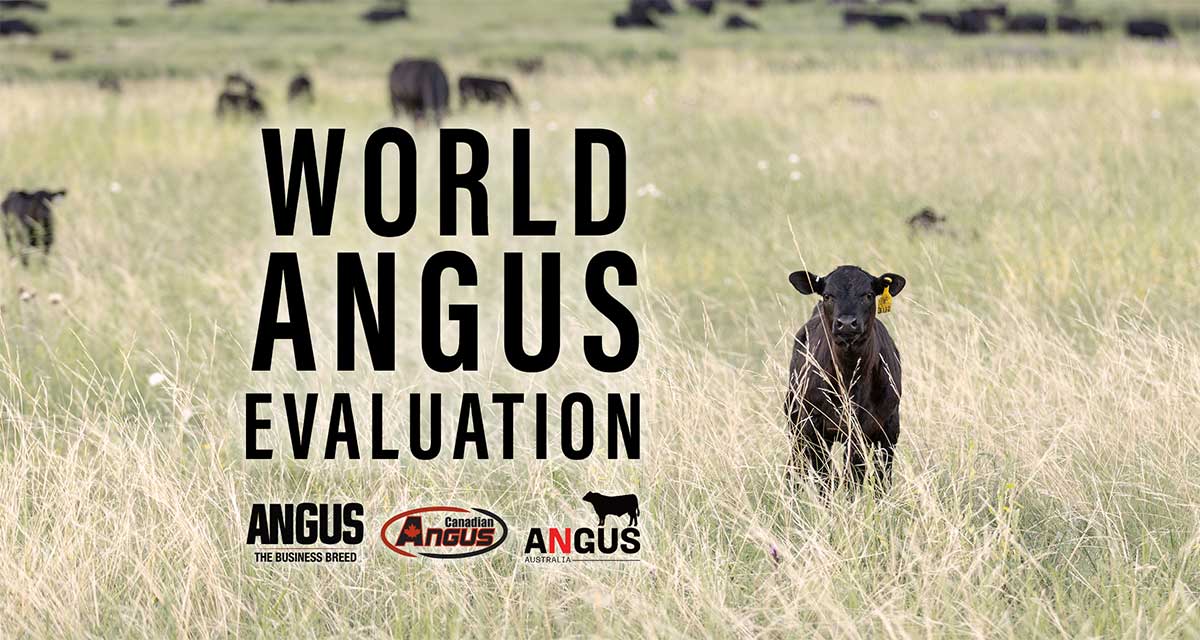World Angus Evaluation Generates Comparable US, Australian, Canadian EPDs


As both the world and the cattle industry become more and more data-driven, cattle breeders want user-friendly tools they can trust. One such tool, the World Angus Evaluation (WAE), is being released October 13th (October 14th Australia Time).
It aims to help eliminate hurdles for cattle producers participating in international commerce with Angus genetics.
Participating groups – the American Angus Association®, the Canadian Angus Association and Angus Australia – have analyzed the breed’s genetics globally to create an international tool for genetic comparisons. The evaluation also uses data from the three groups to produce 11 expected progeny differences (EPDs).
Because the WAE is an expansion of a foot score evaluation released in 2020 by same entities, the claw set EPD (CLAW) and foot angle EPD (ANGLE) are already available in the three-country environment. Angus Genetics, Inc. (AGI®) leads the WAE research efforts for the three groups.
“Putting all the data together leverages each association’s database really well,” said Kelli Retallick-Riley, president of AGI® of the U.S. “We want to make sure that when Angus producers, no matter what country they’re in, go to sell genetics or purchase genetics, they have access to comparable EPDs.”
The 11 additional traits included in the 2023 WAE release are calving ease direct (CED), calving ease maternal (CEM), birth weight (BW), weaning weight (WW), yearling weight (YW), maternal milk (MILK), scrotal circumference (SC), marbling (MARB), carcass weight (CW), ribeye area (RIB) and fat thickness (FAT).
The U.S., Canada and Australia have engaged in the trade of beef cattle genetics for many years, said Myles Immerkar, CEO of the Canadian Angus Association. However, it has not been easy for breeders to translate how an animal from one country scores under another country’s evaluation system.
The common currency created through the WAE will support trade activity and simplify comparing animals’ EPD values.
“There’s a huge efficiency created by us being on the same evaluation,” he said. “If we can do a better job in our evaluations that describe those animals, especially for countries that are doing a lot of trade, I think producers are going to be in much better shape.”
Immerkar cites birth weight records as an example, where more data points create better tools for members. He estimates the Canadian Angus Association has around 1.2 million birth weight records alone, but together the WAE considers 9 million records in its calculations.
“We’re very much focused on technology and particularly providing enhanced genetic improvement technologies for our members,” said Christian Duff, Angus Australia’s general manager of genetic improvement. “Our global initiative is a great step forward for the global Angus community and something we’re really grateful being part of.”
Aside from increasing ease of trade and evaluation accuracies, sharing data with one another helps all three groups because data on some traits is difficult and expensive to collect. Specifically looking at traits related to carcass merit, combining forces allows genetic evaluation for carcass traits to become more robust while avoiding additional costs for data collection.
High-quality research on tough questions often requires collaboration at an international level. A geneticist with AGI®, Andre Garcia, said outside of the WAE the teamwork between international entities has been exciting, because they have valuable discussions about their overlapping work during monthly meetings.
“It’s really fun to be able to work with partners that you trust, you enjoy working with, and that all have similar objectives when it comes to the success of Angus cattle around the world,” Retallick-Riley said.
Duff said that while Angus Australia members are looking forward to the release, he knows there will also be questions about it. For this reason a range of resources are being developed in relation to understanding the results from the WAE.
One piece of good news for Angus breeders in the three counties is the WAE will not change members’ data collection or reporting procedures. Other common questions have been about data security and how the sets were combined. The associations assure their members that their data submissions are being treated with the same care for the WAE as they would be for any other tool or research project.
“Multiple test evaluations and validation procedures were performed to ensure that phenotypes are compatible across databases, and that environmental differences such as age and contemporary groups are properly modelled,” Duff said.
To learn more about the WAE, visit Angus.org in the U.S., cdnAngus.ca in Canada, or AngusAustralia.com.au in Australia.
In mid September, Angus Australia informed members of its’ participation in the World Angus Evaluation. READ MORE